Kostenloser Versand ab 35€ Bestellwert!
-
Shop
- Insights
-
Über ROMBO
- Händler
- Plektren-Finder
- Geschenkgutschein
+Kategorien
- accessories
- bass
- bass pick
- bass picks
- bass plectrum
- bass plectrums
- beginner
- bright tone
- chose guitar pick
- chose guitar picks
- chose plectrum
- chose plectrums
- CrystalBright
- Diamond
- Diamond pick
- discipline and guitar
- DIY generation
- durability pick
- durable pick
- eco
- ecoblack
- find guitar pick
- find plectrum
- fingers vs picks
- grip
- grip guitar pick
- guitar accessories
- guitar advantages
- guitar benefits
- guitar career
- guitar health
- guitar injury
- guitar learn
- guitar lesions
- guitar lesson
- guitar method
- guitar noise
- Guitar noise plectrum
- guitar pain
- guitar pick
- guitar pick beginner
- guitar pick bevel
- guitar pick buy
- Guitar pick diamond
- guitar pick durability
- guitar pick durable
- guitar pick eco
- guitar pick features
- guitar pick grip
- guitar pick material
- Guitar Pick Noise
- Guitar Pick online
- guitar pick recycled
- guitar pick recycled material
- guitar pick special features
- guitar pick textures
- guitar pick thickness
- guitar pick variable thickness
- guitar picks
- guitar tone
- guitar warm-up
- guitarpick
- guitarpicks
- hold a guitar pick
- hold guitar pick
- hold guitar picks
- hold pick
- hold plectrum
- hold plectrums
- how to
- how to chose your guitar picks
- jazziii
- learn guitar
- lose guitar pick
- material
- materials
- mental health and guitar
- motivation and guitar
- music
- not to lose guitar pick
- Online guitar
- online guitar pick
- online guitar pick buy
- pick
- pick durability
- pick material
- pick noise
- Picks
- picks vs. fingers
- play bass fingers
- play bass picks
- play bass with fingers
- play bass with pick
- play bass with picks
- play bass with plectrum
- play guitar faster
- plectrum
- plectrum attributes
- plectrum beginner
- plectrum bevel
- plectrum characteristics
- plectrum features
- plectrum grip
- plectrum material
- plectrum noise
- plectrum recycled
- plectrum shape
- plectrum variable thickness
- plectrums
- Plek
- pua
- recycled
- recycled guita pick material
- recycled guitar picks
- recycled picks
- recycled plectrum
- Rombo Diamond
- rombopicks
- tendonitis guitar
- the guitar pick
- tone
- variable thickness
- warm tone
- warm-up guitar

5 Essential Guitar Accessories Every Beginner Should Own
Starting your journey as a guitarist can be incredibly exciting, but with the vast array of gear and accessories available, it can also be a bit overwhelming. While the guitar itself is obviously the most critical piece of equipment, there are several other accessories that are essential for beginners. These tools not only make playing easier but also enhance the overall learning experience. In this guide, we'll cover five essential guitar accessories every beginner should own.

1. Guitar Picks: The Small Tool with a Big Impact
When you're starting out, it's easy to overlook the importance of a guitar pick. However, this small tool can significantly impact your playing style, tone, and technique. Guitar picks, or plectrums, are used to strike the strings and can produce a variety of sounds depending on their shape, thickness, and material.
Why Guitar Picks Matter for Beginners
For beginners, a guitar pick can make learning easier and more enjoyable. It helps in developing precision, speed, and consistency, which are crucial skills as you progress. Using a pick also reduces the strain on your fingers, which is particularly important for those who are just starting and may not yet have developed the necessary calluses.
The Rombo Variety Pack: Why Exploration Matters
One of the most common challenges for beginners is finding the right pick. Picks come in various shapes, sizes, materials, and thicknesses, and each one can feel different in your hand and produce a unique sound. This is where our Variety Pack comes in. This pack contains 12 picks, each designed to offer a different playing experience. Whether you prefer a warm, mellow tone or a bright, crisp sound, the Rombo Variety Pack allows you to experiment and find what suits your style best.

Exploring different picks is not just about finding what feels comfortable; it’s also about understanding how subtle changes in your gear can influence your sound. For instance, thicker picks generally produce a fuller tone with more volume, while thinner picks are often preferred for strumming as they produce a lighter, more delicate sound. The Rombo Variety Pack gives you the freedom to explore these differences, which is crucial for developing your unique playing style. Link Here.
Investing in a guitar pick variety pack is an excellent decision for beginners. It not only helps you find the right pick for your style but also aids in understanding how different factors—like material, thickness, and shape—affect your tone and playability. This exploration is a critical part of your development as a guitarist and can greatly enhance your learning experience.

2. Tuner: Stay in Tune, Stay on Track
A guitar tuner is another essential accessory that every beginner should own. Playing in tune is fundamental to sounding good and progressing in your practice sessions. There are several types of tuners available, including clip-on tuners, pedal tuners, and smartphone apps.
Why a Tuner is Important
Staying in tune ensures that your practice sessions are productive and that your ear develops correctly. Beginners often struggle to identify when their guitar is out of tune, and practicing with an out-of-tune instrument can slow down your learning and even lead to poor technique. A good tuner will help you quickly and accurately tune your guitar, making sure you're always playing at your best.
Clip-On Tuners: Convenience and Accuracy
Clip-on tuners are especially useful for beginners because they are easy to use and highly portable. They attach to the headstock of your guitar and pick up vibrations directly from the instrument, making them accurate even in noisy environments. A reliable clip-on tuner can become an indispensable part of your daily practice routine, ensuring that you always sound your best.

3. Guitar Strap: Comfort and Stability
A guitar strap might seem like a simple accessory, but it’s crucial for both comfort and stability, especially when playing standing up. For beginners, a strap can help with posture, ensuring that you hold the guitar correctly, which is essential for developing good playing habits.
Why a Good Guitar Strap Matters
A well-designed guitar strap will distribute the weight of your guitar evenly across your shoulder, preventing strain and allowing you to play for longer periods without discomfort. This is particularly important for beginners who are still building up their strength and endurance.

Choosing the Right Strap
When selecting a guitar strap, look for one that is adjustable and made from durable, comfortable material. Leather straps are popular for their durability and comfort, while synthetic materials can offer similar benefits at a lower cost. The width of the strap is also important—wider straps distribute weight more evenly, which can be more comfortable during long practice sessions.
Don’t forget the Strap Blocks!
A strap block is an indispensable guitar accessory, essential for preventing your instrument from slipping and crashing to the floor. This makes strap blocks the top budget-friendly choice and a must-have for guitarists. With strap blocks, you can perform on stage with confidence, knowing your guitar is secure no matter how you move. Link Here!

4. Capo: Unlock New Possibilities
A capo is a small device that clamps down on the strings of your guitar at a specific fret, effectively changing the pitch of the open strings. This simple tool can open up a world of possibilities, especially for beginners who might not yet be comfortable playing barre chords or using alternate tunings.
Why a Capo is Essential
Using a capo allows you to play songs in different keys without having to learn new chord shapes. This can make learning new songs easier and more enjoyable, as you can focus on strumming and timing without worrying about complex finger positions. A capo is also invaluable for playing along with recordings or other musicians, as it lets you match the key of a song without needing to transpose chords.
Choosing the Right Capo
When selecting a capo, look for one that is easy to use and doesn’t put too much pressure on your strings, which can cause them to go out of tune.

5. Guitar Case or Gig Bag: Protection on the Go
Your guitar is an investment, and protecting it should be a top priority. Whether you're taking your guitar to lessons, a friend's house, or just storing it at home, a good guitar case or gig bag is essential for keeping your instrument safe from damage.
Why You Need a Guitar Case or Gig Bag
A quality case or gig bag protects your guitar from physical damage, such as bumps and scratches, as well as environmental factors like humidity and temperature changes. This is especially important for beginners who may not yet be familiar with how to properly care for their instrument. A good case or bag can also make transporting your guitar easier and more convenient.

Choosing the Right Protection
There are two main types of guitar protection: hard cases and gig bags. Hard cases offer the best protection but can be bulky and expensive. Gig bags, on the other hand, are lighter and easier to carry but offer less protection. For beginners, a padded gig bag is often the best choice, as it provides a good balance of protection, portability, and cost.
Bonus -> 6: Multieffects pedal.
A multi-effects pedal is an essential tool for beginner guitarists looking to explore a wide range of sounds without breaking the bank. These versatile devices combine multiple effects—such as distortion, delay, reverb, and modulation—into a single, compact unit. This not only saves money but also reduces the clutter of individual pedals, making it easier for beginners to manage their gear.
One of the biggest advantages of a multi-effects pedal for beginners is its ability to offer an extensive library of tones and effects. Instead of purchasing individual pedals for each effect, a multi-effects pedal provides access to a variety of sounds, allowing beginners to experiment and discover their unique style. This versatility is particularly beneficial for those still exploring different genres, as they can easily switch between sounds suited for rock, blues, jazz, or metal with just a few clicks.
Another key benefit is the user-friendly interface. Most multi-effects pedals are designed with beginners in mind, featuring intuitive controls and pre-set patches that make it easy to start playing right out of the box. This ease of use helps beginners focus on developing their playing skills rather than getting bogged down in technicalities.
In addition, a multi-effects pedal often comes with built-in tuners, looper functions, and amp simulations, further simplifying a beginner's setup. The built-in tuner ensures that the guitar is always in tune, while the looper function helps with practice and songwriting. Amp simulations allow beginners to experience different amp sounds without needing to purchase multiple amplifiers.
Overall, a multi-effects pedal is a cost-effective, space-saving, and user-friendly solution for beginner guitarists, providing them with all the tools they need to explore and refine their sound.
Conclusion
Starting out as a guitarist is a journey filled with learning, exploration, and a lot of fun. While your guitar is the centerpiece of this journey, the right accessories can make a significant difference in how quickly you progress and how enjoyable the experience is.
Guitar picks, in particular, are an essential accessory that deserves careful consideration. The Rombo Variety Pack (Link here) offers beginners an excellent opportunity to explore different picks, helping you find the perfect match for your playing style while also expanding your understanding of how this small tool can shape your sound.

Alongside picks, a reliable tuner, a comfortable strap, a versatile capo, and a protective case or gig bag are all essential accessories that will enhance your learning experience and ensure that you're set up for success. Investing in these accessories from the start will not only make playing easier and more enjoyable but will also help you develop good habits and a deeper understanding of your instrument.

8 Myths about guitar picks
8 Myths about guitar picks
We have been in the guitar pick industry for a couple of years now. During this time, numerous customers have sent lots of inquiries with repeated questions and myths.
We have summarized the top 8 myths that “shocked” us the most, and we explain why they don’t make any sense!

1st Myth: Guitar picks don't influence guitar tone.
In guitar picks, qualities like thickness, material, shape, and size play a pivotal role in tone, feedback, grip, guitar pick noise, sustain, etc…
Why this happens has a simple explanation: Different shapes or materials make the guitar strings vibrate in different patterns.
In our article “Do guitar picks really affect the tone of your guitar” we discuss all the aspects in detail.
2nd Myth: There is a "best" pick for everything
The guitar is one of the most popular instruments because it is versatile. This versatility is achieved by a broad range of techniques. Different techniques require different picks.
Like in every guitar aspect, there is no "better" or "worse".
If you are looking for a brighter sound, then Tortex might be your choice. Nevertheless, if your aim is to get a warmer/darker/deeper tone, other materials like Nylon could perform way better.
The same applies to guitar pick thickness, shape, size, the grip texture, etc.
I recommend having at least 3 to 5 guitar picks for different specific usages. If you do not know where to start you have three options:
- Learn about guitar picks
- A Variety Pack
- Get advice (free advice here)

3rd Myth: You don't need picks if you know how to play with your fingers
Both methods are valid and appropriate for the right musical context. Your goal as a musician is to be able to create the sounds you imagine. The method is up to you!
However, some basic techniques like tremolo picking, palm mute, pinch harmonics, or pick slides are very difficult to perform with fingers. Even more, they are also faster to learn if you use guitar picks. This point also plays a role in keeping your motivation at a high level.
If you love both picking methods you’ll end up with a broader technique repertoire and will profit from both worlds.
4th Myth: Bryan May uses a coin. Everyone should do the same.
You can make a pick out of every item, a penny, paper, old credit cards, or anything else. The important thing here is the joy of exploration. Not the specific taste of one excellent influential guitarist.
Imagine how much you’ll limit yourself if you make the wrong decisions at the beginning of your career.

5th Myth: Guitar picks don't have an influence on speed.
Some qualities like pick shape, a beveled edge, and a polished guitar pick can play an important role in your speed.
“Real” guitar shredders use thick and pointy guitar picks. Probably this combination is the best place to start if you are looking for guitar speed. But remember, the most influential factor when it comes to developing speed is the number of hours of deliberate training!

6th Myth: Once you find a pick that works for you, stick to it forever.
If every song has different requirements, why always use the same guitar pick?
Different guitar picks make a difference in your tone and your playing.
I am not saying that’s impossible to play a “master of puppets” with a 0.38 mm rounded guitar pick. It is all a matter of practice and habits. However, with the right tools, you will learn faster.
In this case, for such a song with lots of palm-mute and downpicking, I would choose a thick, pointy, durable guitar pick, like Rombo Diamond.

If later today, I’m feeling like playing bossanova-jazz phrases with my semi-hollow guitar, I’ll probably use a rounded medium pick. Preferably our of Nylon.
7th Myth: Guitar picks are expensive
This is one of the most controversial aspects related to guitar picks.
You can find arguments for both the “cheap” and the “expensive” side.
Argument: “Guitar picks are expensive”:
- It’s just a piece of plastic
- I’ll lose it very fast
Argument: “Guitar picks are actually cheap”
- If it is a good one, I can use it for over 200 hours (more on durability here)
- It’s the fastest way to change the tone of your guitar
- It’s the bridge between your hands and your instrument and it deserves more attention.
- It costs less than a cup of coffee.
Put in perspective, when you purchase a guitar pick you don’t only “buy a piece of plastic”. Behind the shape and the material development there is a lot of engineering going on.
In addition, you are supporting the infrastructure behind it (customer support, web development, logistics, production, marketing, distribution, R&D, packaging,...). Without one of these single elements, there won’t be guitar picks.
8th Myth: After five seconds on the floor, a pick disappears and goes to an unknown dimension.
This happens after only three seconds, not five.

Do Guitar Picks Really Affect the Tone Of Your Guitar?
Tone, timbre, ring, and sound, are some of the terms that are usually used to refer to the sound waves produced by your guitar and amp.

Music doesn’t understand restrictions. So, one way for you as a guitarist of expanding your repertoire of guitar sounds is by asking yourself simple questions:
- Why should I change the tone of my guitar?
- How do I change the tone of my guitar?
- And… Do guitar picks really affect the tone of my guitar? And how?
We will cover these aspects and discuss some specific examples of guitar picks and guitar techniques and tones.
WHY CHANGE THE TONE OF YOUR GUITAR?
As a guitarist, you should not only reflect on your practice and skill improvements but also look for ways of increasing the amount of totally different sounds your guitar (in your hands!) is able to produce.
Imagine the wide palette of different sounds and effects that you would need to learn 30 songs from different genres.
The advantages of mastering ways to change the sound of your guitar playing are countless:
- Your compositions will be musically richer
- You will develop your innate creativity
- It will force you to learn new techniques
- It will allow you to think out of the box
In other words, you will be a better guitar player.

HOW TO CHANGE THE TONE OF YOUR GUITAR:
Think about the “chain” of connected elements that is present when you play guitar. I like to reverse it and start from the sound source:
It starts with your guitar amp and amp settings and continues through the cable (from a specific brand and specs) and your particular effect pedals. After another couple of cables, your guitar pick-ups, circuitry, wood type, and guitar strings will play a role in the tone too. What comes after that? The guitar pick and your picking hand. Note, that also your fretting hand will have an influence on sound (string pressure).
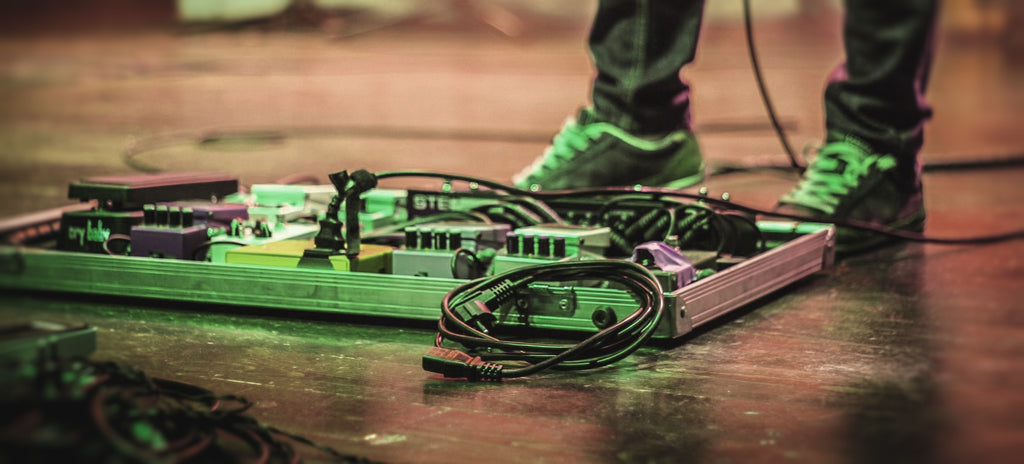
If you replace just one element, the sound will change.
The good thing here is that this is 100% measurable by recording the guitar. So everyone at home with a mid-class microphone can start noticing the differences. Of course, then, the microphone and audio interface will play a role on tone too!
Now you know what to “adjust” to allow you to make the same guitar passages sound differently.
WHY USE GUITAR PICKS FOR CHANGING THE TONE?
Go again through the complete sound chain. From all the mentioned elements, guitar picks have three main advantages when your goal is changing the tone:
- The tone changes immediately: No necessity to plug/unplug new gear or change gear settings.
- Cheap: With a minimal investment you are able to test dozens of products.
- No necessity for knowledge in other areas (recording, effects, settings,...)

Sure, using another guitar or replacing one of your pedals will have a much higher impact on tone! Nevertheless, something as simple as using another guitar pick can create appreciable differences that you will hear and enjoy.
HOW DO GUITAR PICKS CHANGE THE TONE OF YOUR GUITAR?
Guitar picks can be reduced to 4 main qualities: Material, Thickness, Shape, and Size.
These qualities define the “personality” of the guitar picks to at least 80% and they affect how guitar strings vibrate. In consequence, the different guitar string vibration patterns are different.
Some materials like Nylon produce warmer, mellower tones. Others like Tortex, create brighter sounds.
The material can also influence grip and flexibility.
Pointy guitar picks have more attack and produce brighter tones. Rounded guitar picks are especially useful for soft release and warmer tones. In techniques like strumming, rounded picks will produce less pick noise.
Thin picks and some medium picks are very flexible. This quality can produce a very characteristic “snappy attack” that is not possible with very thick picks.
Of course, everything is interconnected: Flexibility also depends on the material and shape! Thickness affects grip and guitar pick noise too.
The larger the pick, the more “mass” it has. Picks with high mass will produce warmer, darker, and fuller tones. Small picks tend to be much less flexible and have a more aggressive attack.
As you can see, you have to consider all factors together. A Tortex pick is able to produce warm tones, it needs to have the right shape, thickness, and size. On the other hand, the same happens to Nylon picks: A very pointy medium-sized Nylon pick can produce brighter sounds than the average less pointy Tortex guitar pick.
Let’s compile three ideal examples:
IDEAL GUITAR PICK FOR THICK, FULL, AND DEFINED OVERDRIVE TONES:
An ideal guitar pick for thick, full, and dark overdrive or distortion sound could be made of Nylon. It should have a sharp tip for note control and at least 1.5 mm thickness. The larger the pick, the thicker and fuller the tone.
One specific example of this could be Jazz iii XL or Rombo Diamond. The last one uses variable thickness along its body to increase its total mass and create even fuller tones with high bass in the background.

IDEAL GUITAR PICK FOR WARM STRUMMING WITH REDUCED PICK NOISE
Strumming is especially easy to perform when the tip of the guitar pick is rounded. To achieve even warmer tones the ideal strumming pick should have enough mass. The material Nylon, in combination with a medium thickness and the already mentioned rounded tip, will help reduce the pick noise.
Depending on your preferences you can use medium thickness or heavy thickness. The last one is more difficult to master but will reduce the pick noise substantially.
Good examples of this are Rombo Origami (medium gauge) or Rombo Waves (heavy gauge)
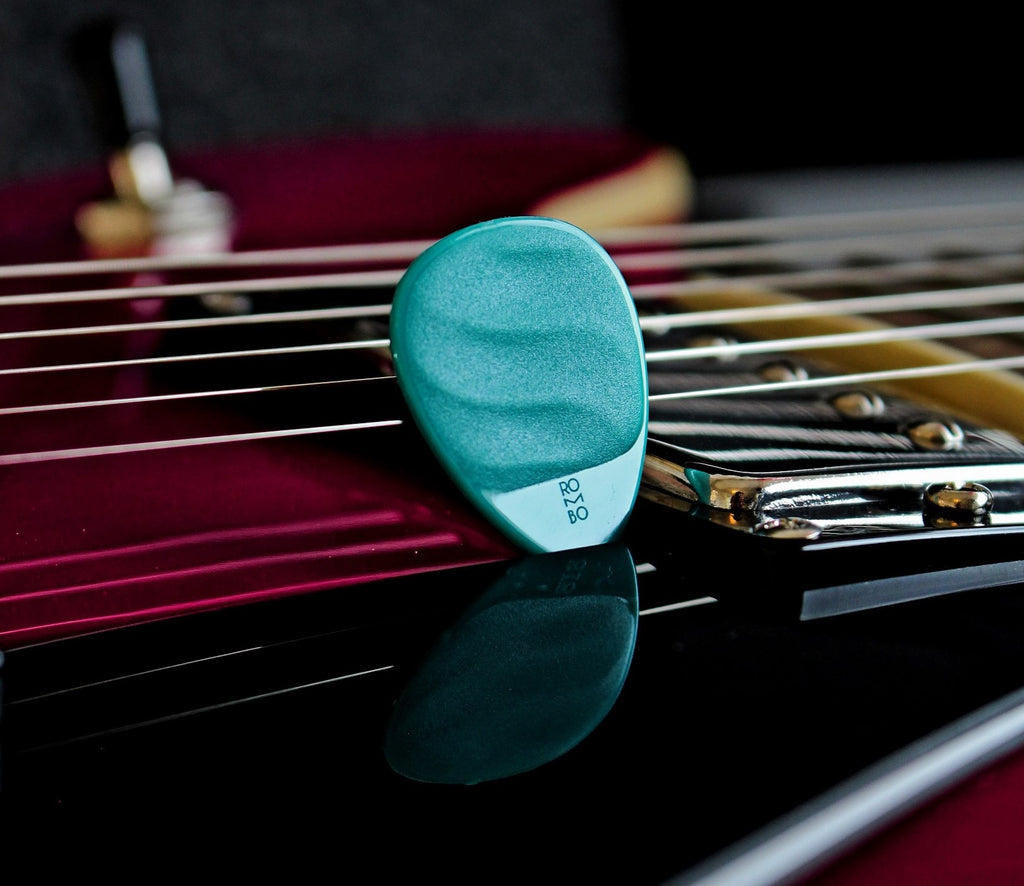
IDEAL GUITAR PICK FOR CLEAR AND DEFINED TONES
Clear and defined guitar tones are produced by pointy pick tips. Ideally, the surface of the tip is polished and has a beveled edge.
Most guitarists prefer small picks for these kinds of tones. Sweep picking, alternate picking, pinch harmonics, and other advanced lead guitar techniques are much easier to perform with such picks.
Depending on your preferences you can then choose different materials: Tortex will increase the attack and create very bright peaks, while Nylon will produce a fuller sound with more bass. Other materials (celluloid, carbon, wood,...) will behave differently.
Rombo Jade is the perfect candidate for speed, control, and attack.

CONCLUSION
Do picks change your guitar tone? Definitely yes!
Not only the tone is affected but other aspects like flexibility, grip, pick noise, attack, or control will be affected by the guitar pick too.
Sound changes will remain as a way of adding some color and dynamic to your music and guitar picks can help you here. With a very low budget and little time, you can experiment and add some fresh input to your daily guitar practice.
The most convenient way of trying many different guitar picks in just one session is by trying a variety pack containing many different guitar picks. Here you can find ours!

Why a guitar pick variety pack is a great choice for beginner and advanced guitar players
1- What is a Guitar Pick Variety Pack
A Guitar Pick Variety Pack is a set of at least three different guitar picks aimed to contain different shapes, sizes, materials, or thicknesses of plectrums.
There are other common names for this type of guitar pick set, like “Try out Mix,” “Guitar Pick Mix Set,” or “Guitar Pick Box.” Some variety packs are focused on specific guitar areas like a “Heavy Gauge Variety Pack,” thought to be used by advanced players or “Beginner’s Variety Pack” containing medium and thin guitar picks.

On guitar picks, qualities like thickness, shape, size, and material play a pivotal role in the guitar tone, sustain, grip, or pick noise.
Therefore, it is not only about the personal preferences of the player but also about the techniques you want to develop. Your hands do an arduous job, give them the proper tools they need.
2- Reasons why a Variety Pack is a good idea
REASON ONE - It is the fastest and cheapest way of changing your guitar tone
Think about it: The guitar, strings, amp, cable, and effects pedals are all pieces of the guitar gear that play a role in tone. Surprise: guitar picks too!
Use a rounded thick nylon pick and you’ll get mellower, darker, and thicker tones. Use a pointy medium Tortex guitar pick and your tone will be as bright as you can imagine.
It only takes two seconds and the cost of a coffee to change your pick and increase your tone spectrum. Larger tone repertoire means larger versatility.
Music is about staying dynamic, and monotony kills dynamics. Therefore, your most logical step as a guitarist is to find ways of expanding your repertoire of tones and techniques. This happens with practice and the right guitar gear.

REASON TWO - The joy of exploration
Music theory, speed exercises, precision exercises, and warm-ups all have one thing in common: They focus on improvement, repetition, and perfection.
However, performance is not everything and sometimes we should focus on the joy of exploration.
The greatest ideas happen when we achieve a “flow” state, also known as the “zone.” This applies to guitar too! So, why not relax for a day, test some new pieces of gear, spark some creativity by playing around some guitar phrases, and then see what happens without planning too much and having the pressure of achieving one specific performance milestone?
Chose 4-5 different picks, turn on the amp, and give yourself a two hours break by enjoying the music you are playing now.
PS: Don’t forget to turn off your phone!
REASON THREE - Develop specific skills
Try to perform your speed exercise with a large, worn-out, thin guitar pick. Let’s say 0.35 mm.
You will face one of these three scenarios:
- You are slower than usual.
- You are as fast as usual but your technique is bad.
- You are slower and your technique is bad.
As in every discipline, using the right tools is the key to success.
“Modern Guitars” are attributed to Spanish musician, Antonio de Torres Jurado. He was a luthier, and in the mid-1800s, he began creating the style of guitar that would rise to all modern guitars.

Imagine then how immense the number of available guitar techniques that had more than a dozen decades to be developed is. From strumming to hybrid picking, palm mute, sweep picking, or down picking, all these techniques have different requirements, and different requirements can be fulfilled with different tools.
In our article, “7 essential guitar pick techniques,” we have summarized some of the most common techniques.
REASON FOUR - Different instruments
Sure, the average guitar player owns a red Stratocaster with 09 strings and plays classic rock.
But what about the rest of us? The 7 strings shredders, the acoustic unplugged fans, the indie effect experts, the experimental music lovers, the metal-heads, the bassists using picks, and the jazz/bossa relaxed musicians out there?
We all deserve to have a choice according to our requirements.

Personally, I like to play bass with a medium pick (Rombo Prisma), and I love the warm tones of Rombo Horizon for guitar reverb phrases on my telecaster. However, when I feel like using the thickest metal distortion ever, I choose Rombo Diamond.
Different guitar pick shapes, sizes, materials, and thicknesses create a widely broad tonality and usability ranges that I need to keep my motivation up!
REASON FIVE - A fresh input kills routine!
Did you use the same guitar pick for the last 20 years? Well, it’s never too late to get a little bit of fresh air and try something new.
Even the riff you have played 1000 times will sound different and you might notice that there are some nuances on “pick feedback” that can make your sound more fun and interesting.
What is the worst that can happen? In the worst case, you will discover a guitar pick that you prefer more than your usual! Go take that risk :-)
REASON SIX - A Guitar Pick Variety Pack is a great gift
Guitar players have a lot of things going on in their heads: the next gig, one unfinished song composition they started some weeks ago, the speed rates of their last practice, and more.

A Guitar Pick Variety Pack is a great gift for beginners, intermediate, or advanced players. Guitarists love trying new gear because it is a way to spark some creativity and explore tonalities.
A variety pack is a super affordable option for a small, but elegant gift to make a guitarist smile and feel excited for the next practice day.
There are many different gift options from Rombo:

If only one of the guitar picks is chosen as the new favorite one, your friend will be thankful for life!
REASON SEVEN - Reflecting on your guitar tone and level
Even if you don’t like the picks included in the variety pack, they will have a positive effect on your playing.
You will reflect and confirm why you had chosen your current pick in the past and what the advantages of it are. You will reflect on your guitar tone and the nuances of guitar pick feedback and pick noise.
These experiences accumulate, and after years of exploration, you start having a sixth sense of “feeling” your instrument, your preferences, and music in general.
What do you do with your new picks? Well, if you don’t like them, give them to a friend that could need inspiration!
3- Who can profit from Guitar Pick Variety Packs (Spoiler: Everyone)
From the reasons above, we can take away a clear lesson: It doesn’t matter if you are a beginner or an advanced player, the advantages of trying a Guitar Pick Variety Pack are always there.
Why beginners profit from Guitar Pick Variety Packs:
- Develop new skills.
- Develop a sense of exploration and identify tone nuances.
- Understand that different techniques need different requirements.
- Understand that the guitar path is a long one and that not everything is performance.
Why intermediate and advanced players profit from guitar pick variety packs:
- Expand the spectrum of techniques.
- Discover an unexpected tonality change.
- Focus on one specific technique.
- Joy of exploration.
4- Examples of a guitar pick variety pack
One example is our own guitar pick variety pack containing:
- 1 Rombo Classic | 0.45 mm
- 1 Rombo Origami | 0.75 mm
- 1 Rombo Prisma | 0.8 mm
- 1 Rombo Crisp | 1 mm
- 1 Rombo Waves | 1.25 mm
- 1 Rombo Horizon | 1.4 mm
- 1 Rombo Diamond | 2 mm
- 1 Rombo Jade | 2.3 mm
It is not only thickness that is everything. In order to make these picks more understandable for you, we have created four metrics: Attack, Flexibility, Tone, and Techniques. Here an example:

With this information, and in combination with the description of the pick and the technical drawing, we give you a very precise picture of the qualities of our guitar picks.
We also have a specific set for beginners with the “Beginners Guitar Pick Gift Box”:
And a specific set for intermediate/advanced players.

5- Conclusion
A Variety Pack is not only an excellent gift for your musician friends, but also for yourself if you are looking to explore tones, develop specific skills, or just need fresh air and try new guitar gear.
Different qualities like shape, thickness, or material, make guitar picks very different tools for different requirements. You will learn a lot in the process of testing them and every fresh input can help keep your motivation at the highest level.
The worst case: You will discover your new favorite pick!
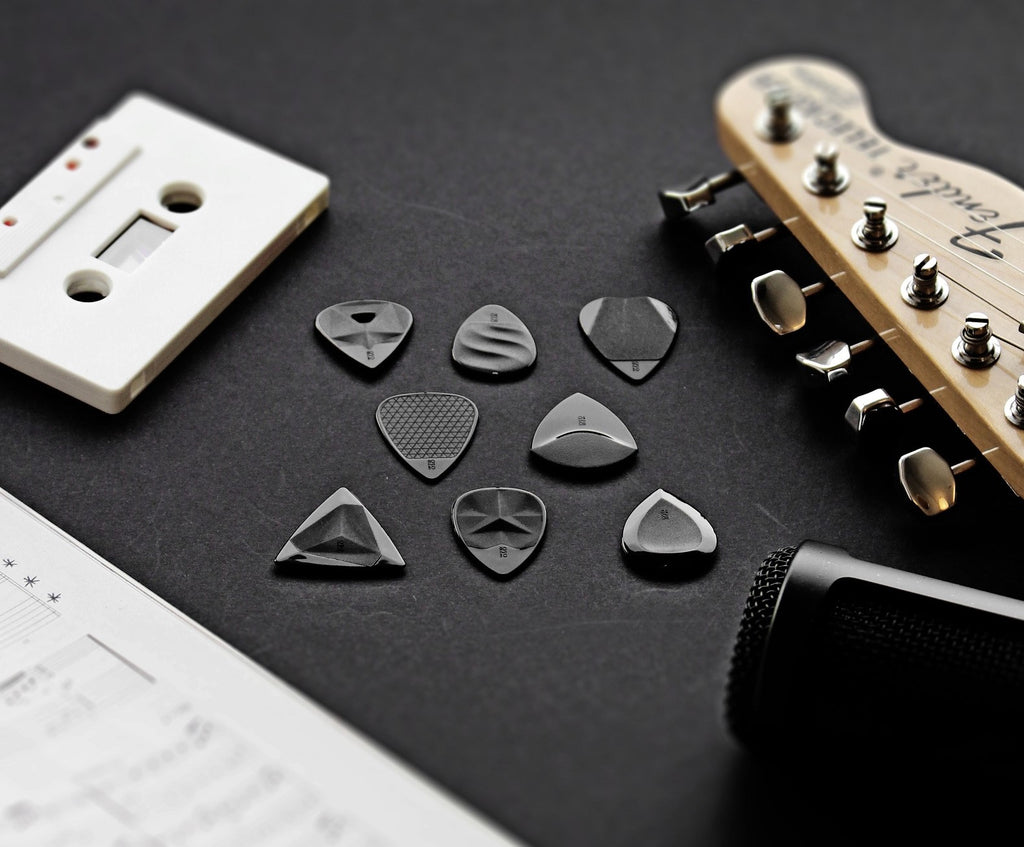

7 Essential Guitar Pick Techniques
One of the most valuable skills when it comes to guitar playing is versatility.
Versatility allows you to adapt to different environments and enriches your playing, making a difference in the final result.
Music is about staying dynamic and monotony kills dynamic. Therefore, the most logical step for you as a guitarist is to expand your repertoire of guitar skills to keep that vital, engaging sound that makes music so joyful.
If you have decided to use a guitar pick for playing guitar, there are seven techniques that are a must.
They will take time to learn and master, but believe me, they make the difference.

1- TREMOLO PICKING:
If you have listened to the music of the last 70 years, you can probably recognize this guitar technique in most rock classic hits.
Tremolo is an Italian word which means “to shake” or “to tremble”.
In the context of guitar, it involves striking one (sometimes more than one) guitar string very fast with alternating strokes. Therefore, this technique is a form of alternate picking. Tremolo picking is very easy to learn but it requires strong discipline and practice to master.
Tremolo picking is essentially useful for any style of music and obviously a big part of the surf guitar sound (I’m a big fan of it!).

In guitar literature, sometimes the words tremolo and vibrato are reversed. This technique has nothing to do with a “tremolo bar” or a "tremolo effects box".
WHY IS TREMOLO PICKING IMPORTANT?
If one of your long-term goals in your guitar learning process is to increase speed, tremolo picking is a good place to start.
It is not only very fun but also can add new textures and some dynamics to your compositions. You would be surprised how well this technique fits even in metal or hardcore music.
A FAMOUS SONG WITH TREMOLO PICKING:
The surf rock version of the song “Misirlou”, from Dick Dale, is probably the greatest example of tremolo picking. The original one is a traditional song from the Eastern Mediterranean area dating back to 1927!
The version of Dick Dale got very popular after appearing in the soundtrack of Pulp Fiction in 1994.
BEST PICK FOR TREMOLO PICKING:
The most influential factors when choosing the best guitar pick for tremolo picking are thickness, material, and grip.
It’s important to have a snappy, responsive guitar pick. For this, medium picks with a medium/pointy tip are my recommendation.
However, there is no consensus in the guitar world for this. Many players have reported preferring thick, rigid picks.
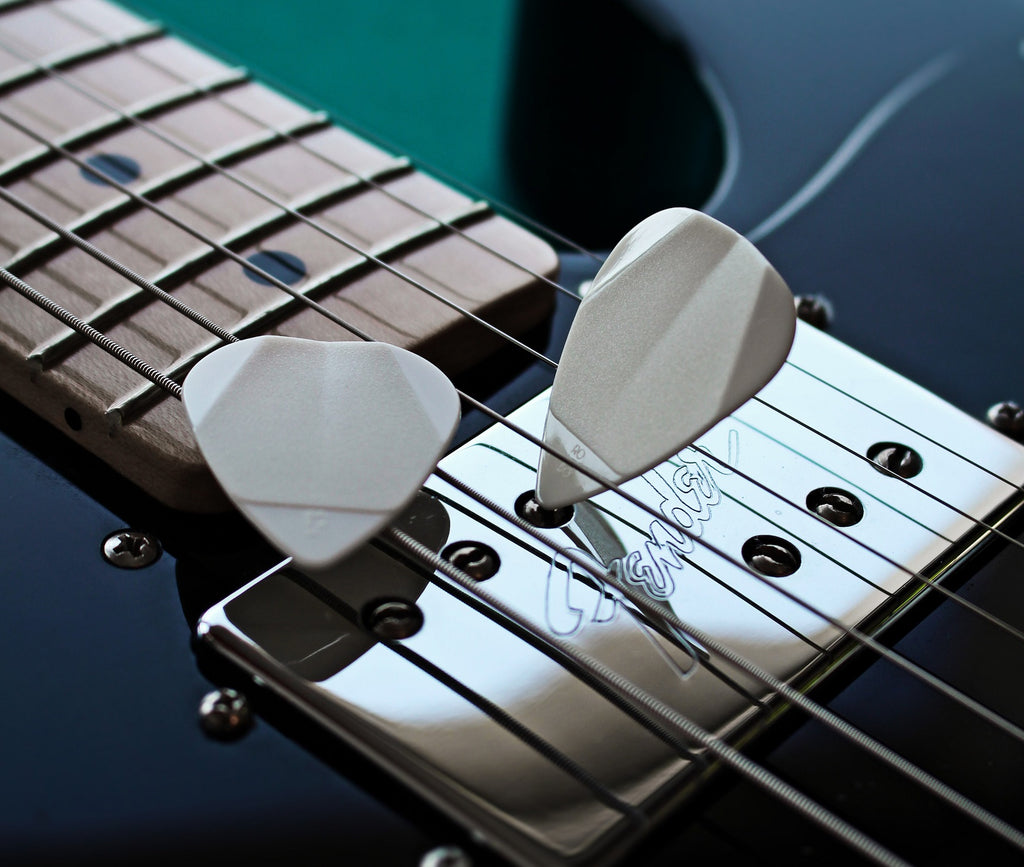
In my case, I have found the best stability and speed using Rombo Origami. This pick can be described as: Flexible but still rigid enough for note control. Right amount of flexibility for a snappy fluid attack that's bright and crisp. The concave surface on the hold area ensures an ergonomic and comfortable hold.
Everyone’s hand is a little different in how they hold the pick and move. The best way to find out is to test different shapes and thicknesses, and then try them out
Good luck!
2- PICK SLIDES:
One very extended technique often performed in the rock, metal, and punk genres is pick slides or pick scrapes.
By holding the edge of the guitar pick against the guitar strings and moving it along the edge, the pick catches the strings’ windings, causing the strings to vibrate and produce a very pleasant textured noise.
Usually, guitar pick slides start near the bridge and end over the higher frets. However, there are countless variations of pick slides depending on the direction, the angle of the pick relative to the strings, and other variables.

Unfortunately, performing pick slides completely ruins the edges of the guitar pick, especially on thinner ones. This won’t directly affect the tone or control of the plectrum, but the damaged sides will develop some dents.
What makes a guitar pick durable? Find our here.
WHY ARE PICK SLIDES IMPORTANT?
Guitar pick slides are not the most relevant aspect of your playing. Nevertheless, a correctly performed slide in the right place will add so much to the moment.

The noisy textures produced by this technique are the perfect weapon of choice for songs using high distortion levels.
A FAMOUS SONG WITH PICK SLIDES:
The first use of the pick slide is attributed to Bo Diddley and can be heard in the opening of his song "Road Runner" from the 60s.
Today, some guitarists have taken this technique to a new level and have created signature variations. A shining example of pick slides from the last years is the metal band Gojira with their famous signature “Gojira-Scrape” that was created by accident and combines several guitar pick techniques
BEST PICK FOR PICK SLIDES:
If you are going to do pick slides frequently, then you need to consider two things:
- Using durable guitar pick materials, and
- Using thick picks.
Otherwise, your guitar picks will be inoperative after a couple of sessions. The dilemma is that most players get better noisy sounds with a medium guitar pick.

I have found a solution that works for me: medium-heavy picks that are large enough to scrape with higher areas of the pick that won’t touch the strings. From our picks, I prefer Rombo Horizon the most for pick slides. Also, the curvy edge creates different pressure on different strings and that’s nice.
3- PINCH HARMONICS:
Do you know any guitar player who does not like pinch harmonics? I do not either.
Pinch harmonics are created by the picking hand. Playing this technique produces high-pitched tones. This phenomenon occurs when you stop a part of the string vibrations in the right position and create a "node".

There is a simple way to test this; pick a note and apply a small pressure anywhere on the string such that the vibration doesn’t stop completely.
WHY ARE PINCH HARMONICS IMPORTANT?
Pinch harmonics are often related to high gain tones and metal music but they are a powerful tool to add dynamics and textures to any genre of music or type of guitar; electric or acoustic.
It is considered one of the most abstruse techniques for intermediate players. Common problems are pinch harmonics that aren't loud enough or additional noises that make the harmonics not sound clean enough.

Root causes of this problem can be:
-
the guitar player does not know the right places on the strings to play pinch harmonics
-
there is unwanted noise coming from unmuted strings
-
the pinch harmonic is produced isolated, without combining it with other techniques like vibrato.
Most guitar players (including me) played their first pinch harmonic accidentally.
A FAMOUS SONG WITH PINCH HARMONICS:
Guitarist Billy Gibbons from ZZ Top is considered the father of pinch harmonics. Not because he invented them, but because he brought them to the mainstream. Although he is a well-rounded guitarist with a focused skillset based on blues, he is best known for his pinch harmonics.
BEST PICK FOR PINCH HARMONICS:
There is no special pick to do pinch harmonics. The pinch harmonic is technically produced by the thumb of your picking hand.
However, this technique is widely used in lead guitar in combination with other advanced techniques that work especially well with thick, small guitar picks.
Therefore, although you can learn pinch harmonics using thin picks, I recommend using thick picks.
 #If you want to learn more about the differences between thin and thick guitar picks read our article "Thick guitar picks vs thin guitar picks".
#If you want to learn more about the differences between thin and thick guitar picks read our article "Thick guitar picks vs thin guitar picks".
4- PALM MUTE:
Palm mute is a very regular technique used by most guitarists. By placing the side of the picking hand on the strings close to the bridge and dampening the guitar strings (when necessary), the strings produce muted sounds.
You can control the dampening effect by moving your hand to a different position further from the bridge.

Although this technique isn't seen as a very difficult one, these are common mistakes that prevent players from learning it properly:
- wrong hand position
- not having a relaxed posture
- problems by keeping a stable tempo
- too much pressure on the strings
WHY IS PALM MUTE IMPORTANT?
As a guitarist or bassist, you are always on the lookout to make your music sound natural, creative, and exciting.
Palm-muting is a great skill for dynamic control exercises. This means you will automatically learn how to shape your sound using fluctuations in volume and intensity.
With this skill in your repertoire, your music will sound more vocal and dynamic.
A FAMOUS SONG WITH PALM MUTE:
This technique is very old. As old as the invention of the electric guitar (1936). Most classical players have been using it for centuries with all kinds of instruments.
Today, palm muting is widely used in heavy metal, thrash, speed, and death metal. It is often found in music that features distortion effects.
Is there any good song to practice palm muting for getting better at it? “Master of Puppets” from Metallica—it’s a masterclass in palm muting and down picking.
BEST PICK FOR PALM MUTE:
I recommend using a thick guitar pick for this. They provide high volume, a broader dynamic range, and more control over single notes (in case you use palm mute arpeggios). In addition, palm muting is a demanding technique that causes a lot of guitar pick wear. As you might know, thick guitar picks are more durable.

My favorite choice for this technique is Rombo Diamond.
5- PICK STRUMMING:
Guitar pick strumming is a way of playing guitar. A strum is a sweeping action where a pick (or finger!) brushes over the guitar strings and generates sounds.
For most guitar players, this is the first technique they learned and the technique that caused most headaches as a beginner.

Learning how to strum correctly takes time and practice. Most beginners lack the necessary muscle memory it takes to play while remaining relaxed or having a good posture.
WHY IS PICK STRUMMING IMPORTANT?
In many ways, understanding this skill is essential for understanding guitar. Great strumming skills mean being a great rhythm guitarist. Therefore, this should be your number one goal as a beginner.
Learning chords is important, but they are just static shapes. The diversity of the hundreds (if not thousands) of strumming patterns available will inject musicality and rhythm into your playing.
A FAMOUS SONG WITH PICK STRUMMING:
“Bad moon rising” by Creedence Clearwater Revival, is a good place to start. It combines easy chords (D, A, G) with a very simple progression and a very catchy, bluesy melody.
BEST PICK FOR STRUMMING:
My best advice for beginners is to start with a very thin guitar pick. It can help to practice with something below 0.6 that’s nice and bendy. As you improve your skills, you can try with thicker picks, as they will add more bass to your tone.

For all the beginners out there, my best choice would be Rombo Classic.
However, if you are in the very beginning of your guitar journey, please read this article where I explain, why starting with medium guitar picks can be a better choice for you. "Medium Gauge Guitar Picks".
6- DOWNPICKING
Downpicking or down-stroke picking is a very beloved guitar technique in which the player moves the guitar pick only in a downward motion. The tip of the pick does not brush the strings as the hand moves back to the original position for the next down-stroke.
It is one of the most underrated skills on guitar and although performing this technique might seem easy, the required endurance for long passages with fast tempo is very often a problem even for advanced guitarists.

WHY IS DOWNPICKING IMPORTANT?
But first, why would you want to remove the upstrokes (alternate picking) and then increase the necessary effort for the same number of strokes? Why would you torture your wrist muscles in this way?
This technique is widely used in metal and punk guitar and the main reason is that when mastered, downpicking can make the guitar’s sound very powerful and rhythmic.
A FAMOUS SONG WITH DOWNPICKING:
Famous punk guitarist Johnny Ramone used this technique in the mid-70s in combination with fast tempo (180 to 200 bpm). The technique was very innovative at that time and influenced many current guitarists like James Hetfield who has been regarded as “the King of Downpicking”.
Many beginner guitarists start with songs from Ramones because of their simplicity in terms of chords and lack of tempo variations.
BEST PICK FOR DOWNPICKING:
For downpicking, there is a basic rule: the more mass the guitar pick has, the thicker and more aggressive the sound.

Therefore, a thick, large guitar pick with a pointy tip will be the loudest and most rhythmic one.
I recommend Rombo Diamond.
7- HYBRID PICKING
The interesting thing about hybrid picking is the fact that the player uses a plectrum as well as one or more fingers. This can be done alternately or simultaneously.
Typical styles for this technique are rockabilly guitar, country and bluegrass, and more classical passages with acoustic or classical guitar.
Hybrid picking can be very hard if you are a beginner. Before you think of learning this technique, you will have to learn how to play with your fingers and with a guitar pick. This is a requirement you cannot avoid.

WHY IS HYBRID PICKING IMPORTANT:
Three major arguments should convince you to learn hybrid picking:
Tone diversity:
The pick is generally used to play bass notes with a longer duration and very noticeable timbral differences caused by variations in the vibration of the strings. Therefore, your playing will sound more interesting combining pick and fingers.
Timing:
Hybrid picking allows you to pick two to four strings simultaneously. This makes it very different from strumming and gives an approach much more similar to piano techniques.
Flexibility:
Managing this technique, you will be able to change between fingerstyle playing and guitar pick playing within the same song or passage.
A FAMOUS SONG WITH HYBRID PICKING:
Hybrid picking was popularized by guitarists like Steve Howe some decades ago. Most players that learn this technique today start with a more classical approach.
A great song to start with this technique is “Amy” by Tommy Emmanuel. However, the complexity of the chords makes this song only possible to play for intermediate and advanced players.
BEST PICK FOR HYBRID PICKING:
There is no such thing as a “good” or “bad” pick for hybrid picking. You can use the pick you think fits the best for the song you are playing.
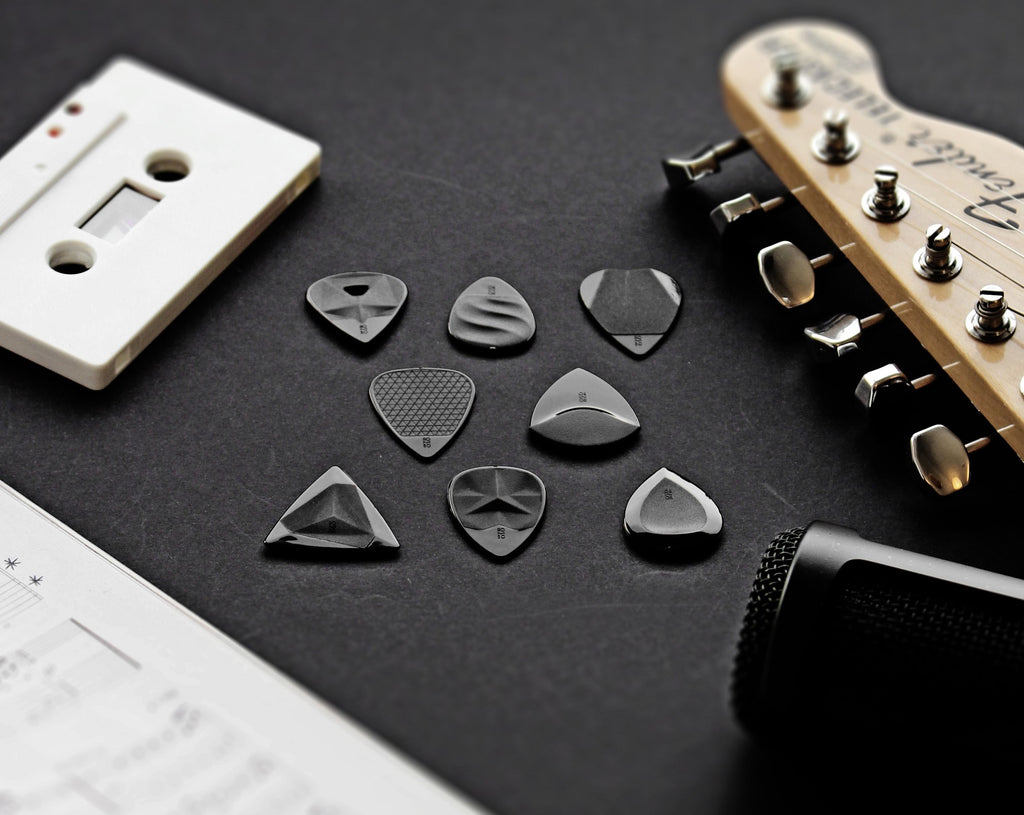
Because this technique is widely used by rhythm guitarists, there is a consensus that picks around 1 mm will perform well. However, it is up to you to try and decide which one is best for every passage.
Discover more about guitar pick thickness here.
8- BONUS SKILL – SWEEP PICKING:
For some reason, sweep picking is the trend. Every guitar forum gets new threads with this topic week after week. Perhaps it’s due to the high speed and visually nice arpeggios that make the guitar produce cyclical sound patterns and put us in a status of trance.

This technique describes the action of playing single notes on consecutive strings using the same motion, either all down-strokes or all upstrokes.
Sweep picking has been recognized as a difficult technique. It is more for advanced players and it can take years to master it.
WHY IS SWEEP PICKING IMPORTANT?
Sweep picking is used by guitarists to play arpeggios at high speed. The phrasing sounds produced by this technique sounds typical of other instruments like the piano.
Although sweep picking is a very important technique for building speed and fluency on string instruments, my advice would be to not learn this technique unless you have mastered other techniques that can give you more versatility.
Sure, it is ok to use sweep picking occasionally but that is not what you are going to play most of the time. In my opinion, a lot of bands overuse this technique. Therefore, you should reflect if the time needed to correctly learn sweep picking could be used for other more relevant skills.
A FAMOUS SONG WITH SWEEP PICKING:
Although often regarded as a “modern guitar technique”, pick sweeping has been around since the 50s. The technique was first used and developed by jazz guitarists.
Today, it is commonly used in metal but many students start with the song “Give Me the Night” by George Benson. Practicing sweep picking with clean tones can help you develop a more accurate technique.
BEST PICK FOR SWEEP PICKING:
What qualities are you looking for in a pick to perform sweep picking? Small and easy to handle, good maneuverability and stability, and good string separation. This means: Thick, pointy guitar picks like Jade or Horizon.

However, I have a bonus for you: We have received some E-Mails from professional guitarists using Rombo Prisma for their sweeping techniques, a pick that wasn’t developed for this. However, its sharp tip, combined with a very large, beveled edge, and the total “mass” of the pick (variable thickness), makes this pick a great candidate for bright tonal sweep picking solos.


Qualities of a premium guitar pick
In our article “How to choose the right guitar pick,” we did a deep analysis on the qualities you should consider when deciding which plectrum to use.
In this article, we will discuss the most important characteristics needed in a guitar pick in order to make the playing experience as comfortable as possible and obtain the best results. These characteristics are not as obvious as others but are essential to getting the most out of this accessory.

1- What is a premium guitar pick?
The Cambridge Dictionary says premium is “used to refer to something that is of higher than usual quality."
Therefore, a premium guitar pick will exceed in qualities like material, shape or texture and will provide a playing experience that’s above average in terms of precision, durability, comfort, tone, or other areas.
Put simply, a premium guitar pick will perform better than regular picks.
1.1 How to achieve premium quality:
Reducing the definition of a guitar pick to its basic intrinsic features, it is easy to understand how to improve certain areas.

For example, it is logical to conclude that better materials will have an impact on the guitar pick’s tone and durability.
Also, with the help of basic ergonomic and design laws, you can create a shape that enhances grip or slides better. The key is to know what you are looking for.
Back in 2018, with the help of a number of professional guitar players, we defined the requirements the Rombo picks had to achieve:
- Excellent tone with minimal pick noise
- Durability
- Comfort and grip
- Great look
- Versatility

With these premises, we started a journey to identify the qualities that would provide an above-average experience in every area.

2- Qualities of a premium guitar pick:
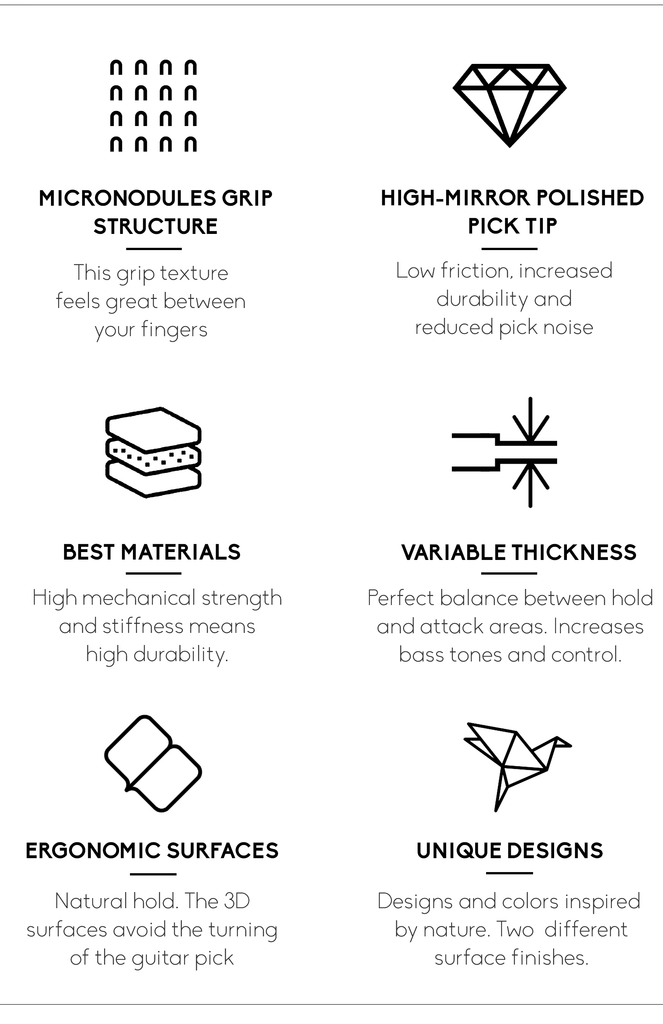
2.1 Micronodules grip texture:
Grippy, non-sticky surfaces are perfect for the guitar pick’s hold area. The best way to achieve this is to create a texture that fits between the grooves of your skin and prevents the guitar pick from slipping or creating an aggressive grip geometry that is uncomfortable for long practice sessions.

When developing the grip texture, our focus was to create a type of grip that allows the player to maintain flexibility and freedom along with a feeling of security and control.
More information on guitar pick grip can be found here.
2.2 High-mirror polished tip:
A guitar pick with a polished tip allows the player to experience more control and less friction. Reduced friction between the plectrum and the strings of the guitar will increase the durability of the pick because it will wear less and reduce its noise.
Noise reduction is a feature especially useful for recording studio tracks.
Furthermore, a polished tip produces more clear individual tones, a requirement for some guitar techniques such as sweep picking.

2.3 Variable thickness:
One of the less common characteristics in guitar picks is variable thickness. It is ideal for the pick to be thick for better control; however, this could significantly reduce its flexibility.
For that reason, plectrums of variable thickness have been created, giving us the best of both worlds.
That is to say, we could have a guitar pick with a solid, thick body that gives us better grip and control. Additionally, it features a thinner tip that provides enough flexibility to achieve greater versatility when developing various guitar techniques.
Remember that an increase in the thickness of only two sheets of paper will substantially reduce the pick’s flexibility!

Read more about the advantages of using a guitar pick with variable thickness here.
2.4 Ergonomic design surfaces:
By following ergonomic models, the surface of the pick can be adapted to feel more comfortable and also look great.
Similarly, we can take advantage of concave or convex surfaces, as they help keep the plectrum’s position oriented and avoid losing control in turning movements.

The shape is also closely connected to the tone of the guitar pick. Just like with the design of a surfboard, you need a specific shape to optimize your energy when catching a wave. The same effect is caused when the guitar pick plucks the strings; different shapes will produce different results.
2.5 High-quality materials:
If your hands are doing an arduous job, then they deserve the best tools, right? Many people spend a lot of money on guitars, amplifiers, strings, and other accessories, but they overlook the guitar pick. This is a big mistake.
The material with which the pick is made can influence the tone, attack, flexibility, durability, and many other aspects. Therefore, without paying attention to it, you can hardly find your personal sound.
Are you curious about the materials used for the Rombo guitar picks? Read a full article on the topic here.

2.6 Unique designs:
The design of everything you own is a way of expressing yourself and defining your personal style.
When it comes to guitar picks, functionality is everything. This is the reason we have spent so much time integrating beautiful geometric patterns that also fulfill the functional requirements for every technique.

3- Conclusion:
In short, guitar picks are personal items that are bound to subjective perceptions. However, some aspects are measurable and can be improved to fulfill requirements that every guitarist needs.
Don’t overestimate this small piece of gear.
Not sure what is the right guitar pick for you? Let us help you here.

New guitar picks for 2021 - How over 1500 guitar players helped us co-design our guitar picks:
In May 2020, Judith and I had finished the first 3D sketches of our four new guitar pick models. However, the picks weren’t 100% ready.
The thickness, the size, and even the names of the picks were still undefined.

We decided to take a new approach and involve as many guitarists as possible to help us co-create our new guitar picks.

What is a signature guitar pick:
Signature guitar picks are common in the guitar pick world.
These picks were developed with the help of some expert and famous guitarists from a specific music field.
From our point of view, this is a very narrow design path that only considers the opinion and guitar playing style of one person.
Our approach: The opposite of a signature pick:
The guitar community has strongly supported Rombopicks since its beginning in 2019.
We did not want to create new guitar picks without asking the people who have been with us since the beginning. You guys and girls are the core of Rombo, and you should decide which products we develop.
The most logical step was to create a big survey to allow users to tell us how they prefer their guitar picks.
We think this is the only way to develop our guitar picks, based on the wants of our users, allowing us to make essential decisions about our company's direction.

This is only possible by listening to the thoughts of every guitar player.
In addition, by asking precise questions about guitar picks, we are able to create more awareness of complex issues, like: Why are guitar picks thick or thin? How they behave when the size changes? Does the flexibility of a guitar pick affect the tone? What about the material?
When the user is aware of the product features, he/she can deliver a useful vote.
Since the beginning, we have been researching all these areas and are sharing them with you. With every article about plectrums we have written, we have contributed to the knowledge you have about your gear so you will be able to decide which gear is the best for you and understand why.
The results of the survey:
Participants:
1.552 guitar players (including us) have participated in the survey and therefore have took part in the design process of these new guitar picks for 2021.
336 of them left a private message with detailed information.

What is your favorite guitar pick design?
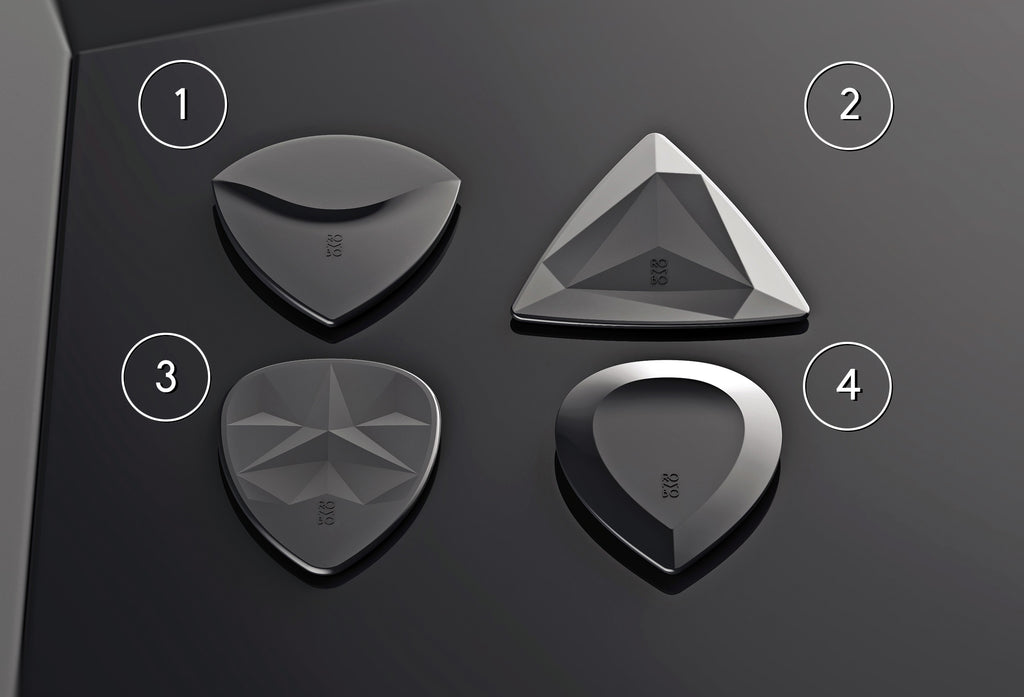
Pick number1: 18,8%
Pick number 2: 14,8%
Pick number 3: 27,8%
Pick number 4: 38,7%
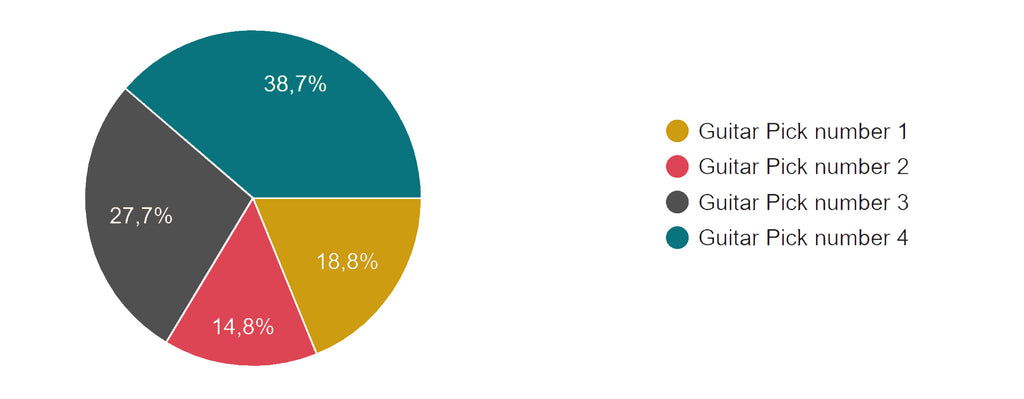
Guitar Pick Number 1:

Name:
Rombo Horizon: 34,5%
Rombo Sense. 33,9%
Rombo Summit: 14,1%
Rombo Mood: 7%
Other names: 10,5%
Average Thickness: 1,378 mm
Average Size: Medium Size with 71% of the votes
Guitar Pick Number 2:

Name:
Rombo Prisma: 76%
Rombo Spin: 7,7%
Rombo Treble: 8,4%
Other names: 7,9%
Average Thickness: 0,831 mm
Average Size: Large Size with 73,5% of the votes
Guitar Pick Number 3:

Name:
Rombo Crisp: 47%
Rombo Split: 22,1%
Rombo Prisma: 16,4%
Other names: 14,5%
Average Thickness: 1,028 mm
Average Size: Medium Size with 59,7% of the votes
Guitar Pick Number 4:

Name:
Rombo Jade: 33%
Rombo Shift: 17,6%
Rombo Slope: 12%
Rombo Summit: 10%
Rombo Dune: 7%
Rombo Cascade: 7%
Rombo Wizzard: 4,9%
Other names: 8,5%
Average Thickness: 2,37 mm
Average Size: Small Size with 56,6% of the votes
Guitar picks: Personal thoughts of 336 guitar players

A total of 336 people left us a private message regarding guitar picks.
We have read all of them carefully and we will use all this information during the development.
Here are the important questions we have received and our comments to them:
-
Will the guitar picks be available in new colors?
Not at the moment. However, we are thinking about creating some additional colors for special editions in the future.
-
Will they have the same grip structure?
Yes! Definitely. Lots of people have sent us e-mails and letters regarding the grip structure. With the micro-nodules, we have the advantage of medium-grip surfaces which add lots of control.
However, a very small number of people want the picks to have more grip. We had to make a decision here, and it was hard.
We won’t forget this topic: In the future, we want to develop a texture with more grip for these players.
-
Why don’t you create different guitar pick thicknesses for each one of the models?
We want every guitar pick to be unique. As every person has unique preferences, we believe every guitar pick should have its own design.
In the future, we hope to be able to create a bigger quantity of different plectrum designs to cover each possible necessity.
-
What about picks for bass players?
Most our picks are compatible with bass, as we have confirmed this with some bassists that are using them regularly, especially Rombo Diamond ad Rombo Origami. We explained this HERE.
-
You should create some merch, T-Shirts and other stuff:
Maybe in the future. Now, we want to focus 100% on the development of the guitar picks. Every minute we spend on the design of a T-Shirt will be taken away from the quality of the picks! ;)
-
Will you offer the EcoBlack range in other colors?
The EcoBlack material can only be produced in one color at the moment. The recycling process creates a very dark pigmentation. The industry is working hard to find a way to create new recycling processes. We hope we will manufacture all of our picks out of recycled material in the future.
When will be the new picks available?

The new guitar picks will be available in early 2021.
If you want to receive an E-Mail as soon as the picks are availabe, join our mailing list below on the footer.
This is the timeline we created for this project:

The pre-order product launch will be on the platform Kickstarter (like the first generation of Rombo guitar picks we launched in January 2019).
However, the current development of the Covid-19 could postpone the project a couple of months. We want to launch the product when we are able to deliver worldwide.
Why Kickstarter?
Kickstarter campaigns turn dreams and ideas into reality. Rombo is still a small start-up run by two people, and with limited access to resources. Through Kickstarter, we involve the community of guitar players, showing our guitar picks before launching.
This process brings us in contact with the real guitar players and their necessities. It forces us to remain flexible, accept changes, and challenges us to create new designs to fulfill the expectations of our audience.
We love open and critical criticism, and this is the best place to get it, where all comments and thoughts are visible. By sharing your experiences, we can listen to your needs and wishes, and create guitar picks that make a difference.

Guitar Pick for Beginners
Guitar picks are one of the most useful accessories for beginners, who have just started to play the guitar or bass.
Having a guitar pick won’t make you a professional guitar player faster, but will enhance the playability of your guitar.
With the right plectrums, you can easily learn new techniques and shape your skills.

The amount of guitar pick brands available on the market today is huge. This can be overwhelming if you are a beginner guitarist, and choosing the right guitar pick can be a tough process if you start in the wrong place.
But first of all: Who is considered a beginner guitar player?
Who is Considered A Beginner Guitar Player?
A beginner guitar player could be someone who just started playing last week, or, someone who has been practicing guitar for 2 months.
It is very difficult to define a line between the beginner and intermediate stages of guitar playing. Especially when you have learned to play the guitar yourself.

In general, to be considered an intermediate player, you should know and master the following areas:
- Change smoothly between fundamental open chords.
- Know power chords and be able to move around then cleanly.
- Know the difference between major and minor basic chord shapes and sounds by hearing.
- Know the note positions on the fretboard for the low E and A strings.
- Having mastered a significant amount of strumming patterns.
- You are able to practice using a metronome, and are aware of your comfort tempo for every technique.
- Have a basic understanding of music theory for musical keys and chords.
- Play through several complete songs smoothly.
- You’ll need to feel familiar with the basic lead techniques of picking, bending, and sliding,...
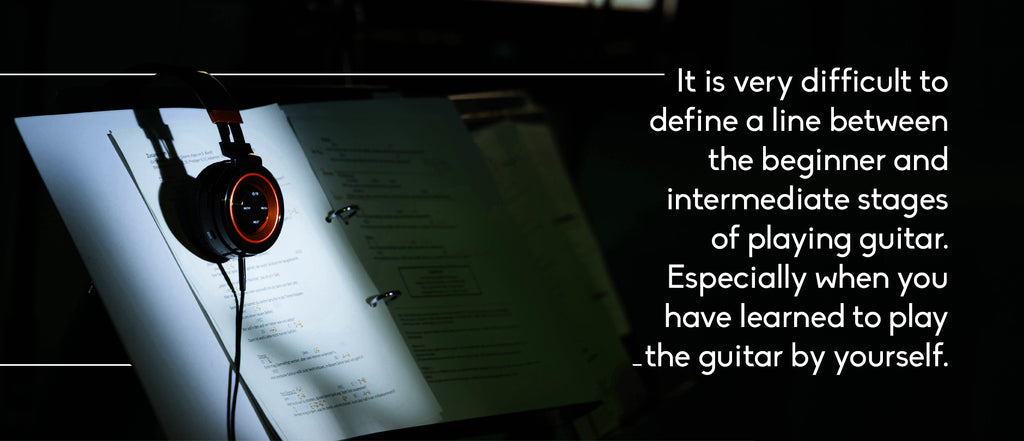
Why Use Guitar Picks?
Guitar Picks have different advantages when comparing them with fingers.
Guitar picks help increase your playing speed, produce a louder, brighter sound than fingers, and can be shaped to achieve better results when using different techniques like strumming or palm mute.
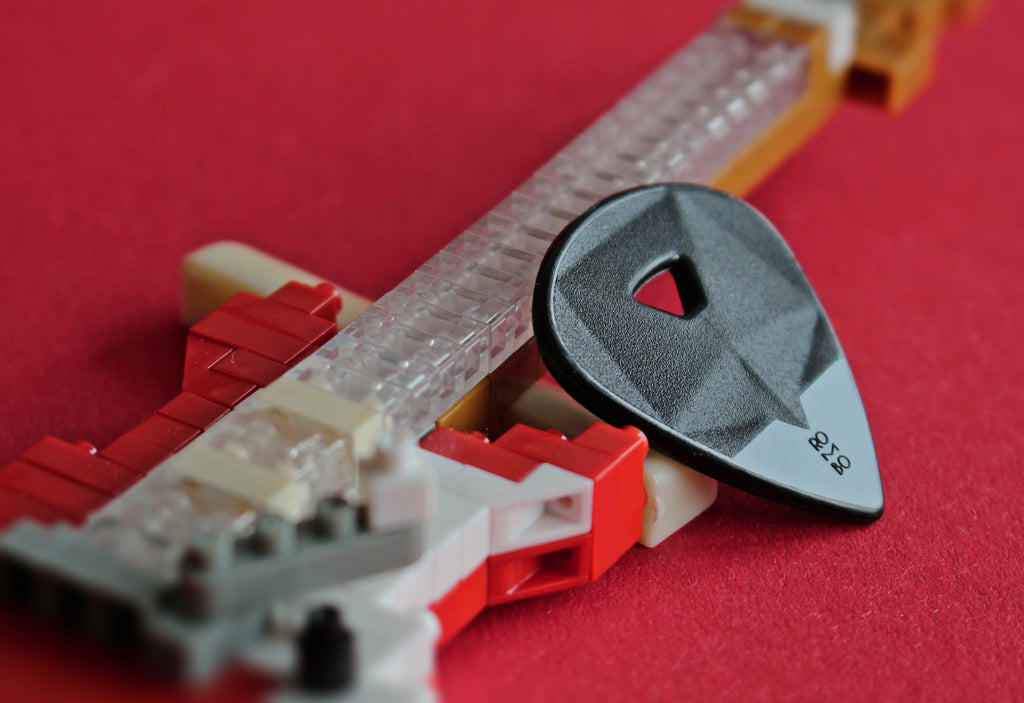
In general, plectrum techniques are easier to master than classical fingerstyle, or hybrid. It is easier to play fast picked notes.
As a beginner, this is very motivating, since your process of learning will be accelerated.
Guitar Picks - Quick Guide:
At the very beginning of your guitar learning process, your feeling of sound and feedback provided by a guitar pick as not yet developed.
Therefore, you should consider only these two attributes of a guitar pick:
- Guitar Pick Thickness
- Guitar Pick Shape.
Simplifying the “science” of a guitar pick will help you make a fast choice without spending too much time and stress.
After your first couple of months playing guitar, you will develop new skills, which will allow you to introduce more complex factors to your final decision of which pick to buy, guitar pick material, guitar pick size, and other special features.
If you feel secure enough to understand these additional features of a plectrum, go to our guide: How to choose the right guitar pick, which you can find HERE.
For the thickness and the shape, here is where you should begin:
0,75 mm Guitar Picks: The Best Choice for Beginner Guitar Players
Light guitar picks with less than 0,6 mm are considered beginners’ guitar picks.
The reason for this, is that most beginner guitar players first learn strumming techniques, which can usually be played better with thinner plectrums.
However, medium guitar picks with 0,75 mm thickness are the best place to start.

Plectrums with medium thickness are the most versatile in terms of tone, and can be used for rhythm and lead guitar.
If you are having fun with strumming exercises, medium thickness will perform well. If you need to practice some lead guitar techniques, it will work as well.
Depending on the kind of guitarist you want to become, you may consider moving to a higher or lower thickness range afterward.
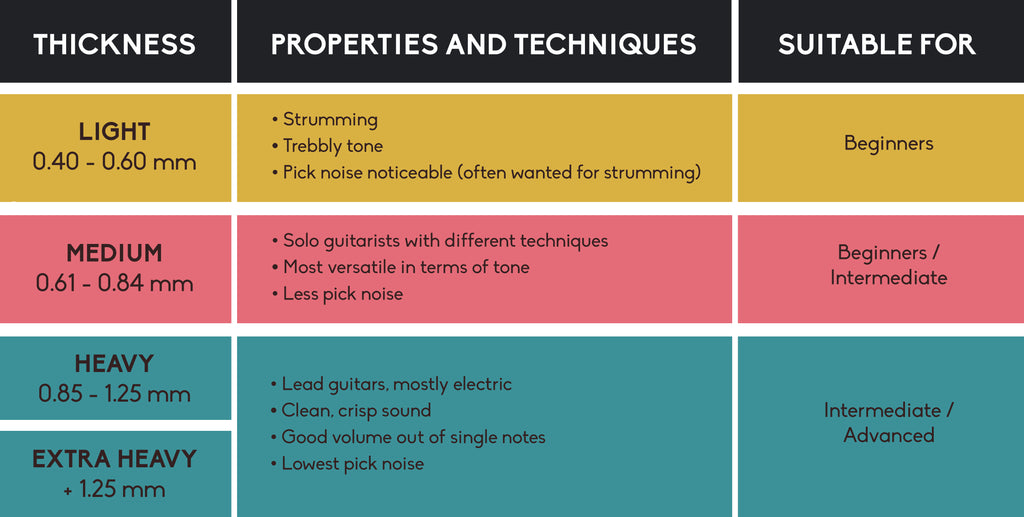
Rombo Origami is a good example of a medium thickness guitar pick.

Teardrop Shape and Standard Shape Guitar Picks: The Best Choice for Beginner Guitar Players
Teardrop shape and standard shape guitar picks are simply the most common shapes for plectrums, and globally famous by every single guitar player.
You cannot go wrong if you use one of these shapes for your first guitar pick.
Both picks have enough surface for a solid grip, and the tip has mostly a medium radius, and often even a light bevel edge for smoother playing.
When is it time to change the guitar pick?
I am not talking about wear and tear. For this, we already published the article “Guitar Pick Durability”
What I really mean is, when is it time to question the guitar pick model you are using and use a different thickness or a different material?
Avoid sticking with a single guitar pick model for the rest of your life.
Using different guitar picks will give you the possibility to increase your tonality ranges, develop a more accurate feeling for different guitar techniques, and be more aware of your preferences when it comes to guitar gear.

Therefore, the answer is: always! I cannot recommend enough, the benefit of testing as many different plectrums as possible, and then decide which ones are your favorites.
I used the plural noun “favorites”, because you should find at least 3 of your top guitar picks.

As you develop your skills as a guitarist, you will notice that some guitar pick shapes, or guitar pick thicknesses, are more adequate for specific techniques.
Discover our variety pack HERE
In my case, I like medium picks for strumming, hard ponty guitar picks for practicing scales and loud music, and very rounded guitar picks for the days I just want to relax, use my reverb pedal, and create beautiful clean guitar melodies.
Conclusion: The Right Guitar Pick For Beginners
An important part of learning guitar, is knowing the gear you use: The amplifiers, the pickups, the different guitar strings, the guitar pedals, and also the guitar picks.
Don’t feel overwhelmed by the amount of guitar picks out there. It’s just a matter of preference, and you will have to spend some time trying new guitar picks, which can be fun and bring you some nice experiences.
You can start with a standard shaped guitar pick with 0,75 mm thickness. But, if you don’t feel comfortable with just one option, try a variety pack, containing some different guitar picks. Close your eyes, and chose the guitar pick that feels right to you.
Please leave a comment and tell us the thickness of the first guitar pick you had. Thanks!
Folge uns
Judith Heindorf & Carlos Diez Macia GbR
Auf der Steige 29
71686 Remseck am Neckar
DEUTSCHLAND
- Shop
- Händler
- Impressum
- AGB
- Widerrufsrecht
- Versandbedingungen
- Datenschutzerklärung
- Kontakt
- Presse
- Fragen & Antworten
Melde dich zu unserem Newsletter an und erhalte alle Neuigkeiten zu Sales, Neuerscheinungen und vielem mehr…
Mit der Anmeldung stimmst du unseren Datenschutzbedingungen zu.
© 2025 ROMBO.
ist eine registrierte EU-Marke.
Wir nutzen Shopify.

